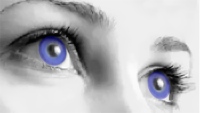|
|
|

|
|
|
| Hours |
|
|
| Monday: |
|
10:00 - 6:00 pm |
| Tuesday: |
|
10:00 - 8:00 pm |
| Wednesday: |
|
9:00 - 1:00 pm |
|
| Thursday: |
|
10:00 - 8:00 pm |
| Friday: |
|
10:00 - 5:00 pm |
| Saturday: |
|
9:00 - 2:00 pm |
|
|
|
|
| |
|
What is a Dry Eye? |
|
Many times in our lifetime, we will experience a "foreign
body sensation" in our eye. That usually happens if the wind
blows dust, an allergen or a foreign body into our eye or under
an eyelid. This should not be dismissed as just an uncomfortable feeling.
It
needs to be remedied. It cannot be allowed to linger or fester.
For many, the feeling of grittiness, dryness,
burning or stinging or even excessive tearing cannot be relieved
simply, or with over the counter methods. It may be the
sign of a chronic condition known as dry eye syndrome. Yes, even
tearing eyes are a sign of dry eye. |
| |
|
The tears your eyes produce are necessary for overall eye health
and clear vision. Dry eye means that your eyes do not produce
enough tears or that you produce tears that do not have the
proper chemical composition. Dry eye is more common as we age.
It can also be caused by blinking or
eyelid problems, medications like antihistamines, oral
contraceptives and antidepressants, a dry climate, wind and
dust, general health problems like arthritis or Sjogren's
syndrome and chemical or thermal burns to your eyes.
 |
|
If you have dry eye, your symptoms may include irritated,
scratchy, dry, uncomfortable or red eyes, a burning sensation,
excessive tearing, blurred vision, or a
feeling of something foreign in your eyes.
Excessive dry eyes may damage eye tissue, scar your cornea (the
front covering of your eyes) and impair vision and make contact
lens wear difficult.
|
Any condition that
reduces the production, alters the composition, or impedes the
distribution of the preocular tear film (POTF) may cause a
noticeable irritation to the structures of the front surface of
the eye and a degradation of vision. These conditions are often
related to problems with the structure or function of the
eyelids, cornea, or conjunctiva. Depending upon the severity of
symptoms, individuals may be limited in their ability to see
clearly and comfortably and may be at increased risk of
developing secondary infection or chronic inflammation that may
not respond to treatment.
The two most commonly encountered ocular surface disorders are
tear film disorders and blepharitis. Additional
subclassifications include those dry-eye states associated
with systemic connective tissue disorders, specifically Sjogren
syndrome (SS). With regard to lipid deficient tear-film
disorders, the involvement of meibomian gland dysfunction (MGD)
has been proposed. |
| |
|
An estimated one-fifth of visits to
eye care practitioners are related to ocular complaints
secondary to dry eye, and as many as 25 percent of
American adults may be affected by dry eye or have dry
eye symptoms. These statistics indicate a significant
need for access to professional care.
|
|
| |
|
|
We perform specific tests to assist in
differentiating the various forms of tear film abnormalities and
identifying potential treatment strategies. Careful clinical
observation, accurate diagnosis, and appropriate intervention
can eliminate or minimize the deleterious effects of ocular
surface disorders on the quality of life. |
| |
|
|